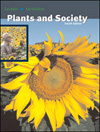 |  Plants and Society, 4/e Dr. Estelle Levetin,
University of Tulsa
Karen McMahon,
University of Tulsa
Plant Ecology
Chapter Summary| 1. The ecosystem is the functional unit of study of the environment. The environment is an organism’s surroundings; it includes the study of biotic factors such as the interrelationships between organisms as well as investigations into abiotic factors such as energy flow and the cycling of mineral nutrients.
2. Ecological niche is the functional role an organism plays in the ecosystem. Plants as producers are fundamental to most food chains, the sequential ordering of trophic relationships.
3. Biological magnification is the transfer and concentration of a toxic substance as it is passed along a food chain.
4. Human impact on the carbon cycle has resulted in the greenhouse effect, in which the buildup of CO2 acts as a heat trap warming Earth’s lower atmosphere. Global warming is likely to cause a shift in agricultural regions and in the range of many species of plants and animals.
5. Ecological succession is the gradual progression of orderly and predictable changes that may occur in ecosystems over time. The end point of ecological succession is the climax community.
6. Biomes are large, terrestrial regions recognizable by their distinctive vegetation and animal life. Climatic conditions, such as temperature and precipitation, largely determine the type of biome that develops in a region. Major biomes of the world include the desert, chaparral, grassland, savanna, tundra, boreal forest, moist coniferous forest, deciduous forest, and tropical rain forest.
7. The strategy of extractive reserves is an attempt to preserve the tropical rain forest from destructive exploitation by developing economic markets for a renewable harvest of natural products such as natural rubber, chicle, Brazil nuts, and vegetable ivory.
8. Several methods of forest management are currently in practice: clear-cutting, strip-cutting, whole-tree harvesting, shelterwood, selective cutting, and short rotation. Clear-cutting is the most controversial because this method produces significant damage to the environment: soil erosion, decline of soil fertility, sediment run-off into the watershed, and loss of habitat. Selective cutting is the least damaging to a forest. Most of the forest is left intact because desirable trees are cut for timber as they reach maturity. |
|



 2006 McGraw-Hill Higher Education
2006 McGraw-Hill Higher Education

 2006 McGraw-Hill Higher Education
2006 McGraw-Hill Higher Education